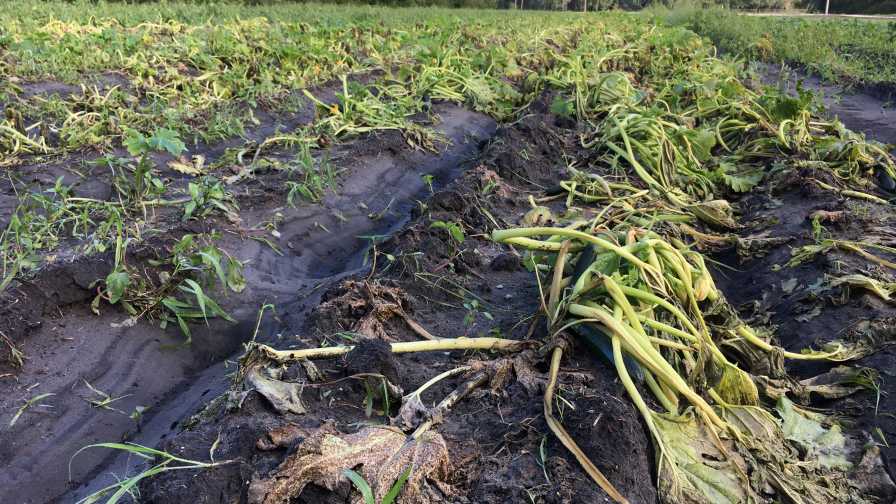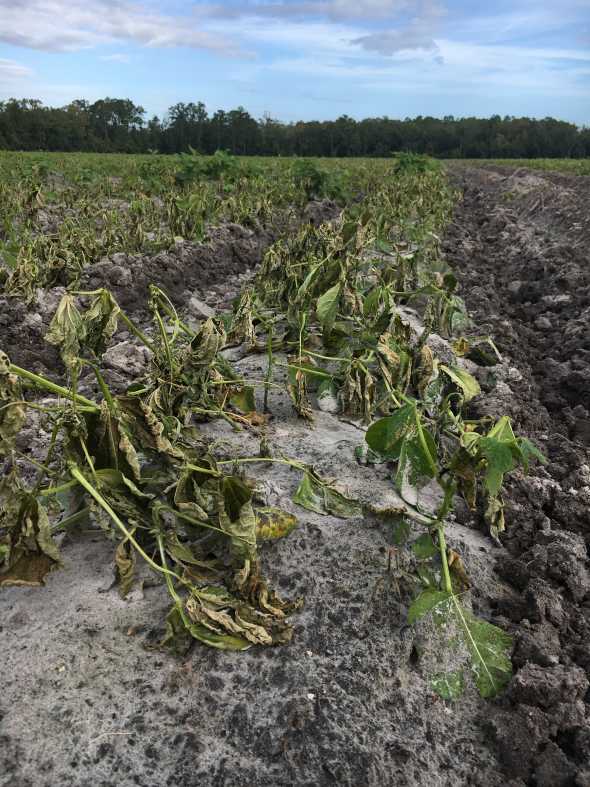Damage Assessments, Recovery Begin In Wake Of Matthew

This field of squash in Northeast Florida was slammed by the rain and wind from Hurricane Matthew.
Photo by Bonnie C. Wells
Updated Oct. 26, 2016, 9:34 a.m.
When NOAA released its revised Atlantic hurricane forecast in August, it was predicted the second half of the season would experience heightened activity. So far, the forecast has been spot on — and then some.
Following an 11-year period with no direct hurricane strikes, Florida not only saw the streak broken with the landfall of Category 1 rainmaker Hermine in early September, but is now recovering from significant impacts left behind by Hurricane Matthew, a major storm that also caused havoc in Haiti, Cuba, and the Bahamas.
Though the eye of the storm did not make landfall in Florida, the major hurricane ground its way up the East Coast of the Sunshine State, lashing areas with damaging winds, copious amounts of rain, and devastating storm surge. Coastal areas from Daytona Beach northward to Jacksonville were particularly pounded hard by the surge, which caused major flooding.
Bonnie Cook Wells, a UF/IFAS Commercial Agriculture Extension Agent based in St. Johns County, spent Monday morning performing assessments. Approximately 1,100 acres of crops were impacted by the damaging winds and rainfall in the county, Wells reports. “We had more than 10 inches of rain in the Hastings area with very strong winds,” she says.
On average, St. Johns County farmers have reported 30% to 60% losses of their planted acreage, while several have experienced a 100% or total loss for the crops they had in the ground before the storm, Wells states. “The Asian vegetables in the area were hit really hard, and so were the snap beans,” she says. “Other crops lost include mustard greens, radishes, cabbage, cauliflower, squash, beets, and more. But, a few fields of cabbage and cauliflower look like they might bounce back. We will have to see in a week or so. And then, the crops that do make it, I am expecting worse than usual disease pressure.”
According to Wells, losses are estimated at least $1.6 million for Asian vegetables and snap beans alone. In addition, she notes structural damage to greenhouses and other farm structures resulted from the storm, and the soggy grounds have delayed planting of much of the area’s fall crops.
Scanning southward, Volusia County also took a wallop from Matthew’s wrath. As the coastal areas took a beating, the county’s diverse agriculture industry wasn’t spared either, says Sharon Fox Gamble, UF/IFAS Extension Agent, whose office is located in DeLand. “Citrus losses are estimated anywhere from 10% to 50% depending on location, tree, and fruit size,” she says. “The fern/cut foliage industry had extreme damage to the shade structures and, from what I understand, the saran cloth is unavailable. These crops easily sunburn and will be ruined if growers are not able to figure something out in a hurry. And of course, there are lots of trees on fences and several reports of barns missing roofs.”
Steve Crump, a fourth-generation grower who manages Vo-LaSalle Farms in DeLeon Springs, says his operation came through the storm fairly well. “The citrus looks to have minimal damage,” he says. “Some fruit will fall on the ground, but not much. Vegetables didn’t fare as well. Some of the beans, squash, and cucumber are wind damaged and will need to be replaced.”
Despite the minimal set-back in workflow — especially with storm preparations — Crump says the farm’s market, U-Pick, and other agritainment activities are open for business.
Brevard County, which at one time was in the bulls-eye of Matthew’s track, fared better than expected during the storm, says Joe Walter, Agriculture Agent at the county’s UF/IFAS Extension office in Cocoa. “We were truly lucky,” he says. “Major damage was to the citrus crop with about a 40% loss of fruit, but minor damage to the trees. Vegetable crops were not planted yet, but beds, drip tape, and plastic mulch were in place before the storm and mostly absent post Matthew.”
According to a preliminary storm report from the National Weather Service in Melbourne, FL, Matthew’s strongest winds — as it howled past Brevard — were recorded at Port Canaveral’s U.S. Air Force Tower #3, clocking in at 107 mph.
Walter points out an unexpected silver lining from Matthew. “This part of the state was very dry before the storm,” he says. “We received about five inches of rain during Matthew, which caused minor flooding for a short period of time, draining rapidly due to the unusually low water table for this time of the year.”
How Florida Agriculture Weathered Hurricane Matthew’s Greatest Hits [SLIDESHOW]

In the wake of Hurricane Matthew, an annihilated planting of snap beans lay in a field near Hastings, FL. Snap beans were some of the most heavily affected crops in St. Johns County.
Photo by Bonnie C. Wells
Regarding how the state’s citrus crop fared, especially in the Indian River region, Andrew Meadows of Florida Citrus Mutual says the sector came through in pretty good shape. “There was some fruit drop on the East Coast, but nothing catastrophic. The fact the storm never made landfall really helped us.”
Doug Bournique, Executive Director of the Indian River Citrus League, says at first glance, expectations are for light losses to the crop. “We’re still assessing,” he says. “We’ll truly know (the extent of the damage) in about 10 days. Damage is light compared to what we thought would happen. Everybody is breathing a sigh of relief.”
Beside the fact Matthew’s eye stayed offshore while blowing past Florida, another big difference Bournique points out when comparing this tropical system’s impact to the destruction caused by the multiple hurricane strikes of 2004 (Frances and Jeanne) and 2005 (Wilma) is the presence of windbreaks — rows of clumping trees strategically planted to break the force of the wind. Before 2004, a lack of windbreaks left groves unprotected. In the last decade, windbreak trees have had time to be planted, grow, and in this case — do their job. “We dodged a really big bullet,” Bournique exclaims.
Following the storm, Florida Senators Marco Rubio and Bill Nelson took an aerial tour with the U.S. Coast Guard to scan the extensive damage from above. The birds-eye view provided perspective to the damage inflicted, most notably the storm surge washout along portions of SR A1A in Flagler and Volusia counties.
While a slightly weaker Matthew crept northward, coastal Georgia, South Carolina, and North Carolina were inundated with record rains that easily overtook the area’s low-lying, marshy wetlands.
Even though damage assessments are ongoing, early estimates have come in at $4 billion to $6 billion, according to CoreLogic, a global property information and analytics provider.
CoreLogic’s analysis looks at insured property losses for both residential and commercial properties and is based on wind and storm surge damage. This does not include insured losses related to additional flooding, business interruption or contents. Of this $4 billion to $6 billion, 90% of the insurance claims are expected to be related to wind and 10% is expected to be related to storm surge.
When factoring in economic losses and business interruption due to Matthew, the losses could elevate exponentially.
What Next? What To Do After A Natural Disaster At Your Farm
Out ahead of Hurricane Matthew, USDA released a memo for farmers and ranchers, families, and small businesses about several programs the agency has available to provide assistance before, during, and after disasters.
“USDA has offices in nearly every county in the U.S., and we want to remind people that we have a variety of services that may be useful in challenging times like this one,” stated U.S. Agriculture Secretary Tom Vilsack.
During the initial stages of storm cleanup, FEMA announced assistance availability for individuals and businesses in Brevard, Flagler, Indian River, Putnam, St. Johns, and Volusia counties. Duval, Nassau, and Seminole counties have since been added to the list for FEMA assistance. Those affected may apply for federal disaster assistance for uninsured and under-insured damages and losses resulting from Hurricane Matthew.
According to FEMA, to be eligible for federal aid under the Individual Assistance Program, storm damage and losses from the hurricane and flooding must have occurred as a result of Hurricane Matthew, beginning on October 3.
FEMA will continue to survey additional counties along Florida’s East Coast to determine if further assistance is needed.
This story will be updated as the situation progresses.




